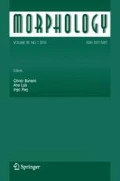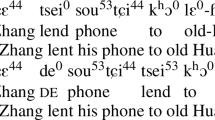Abstract
In many varieties of Southern German the contrast between /s/ and /\(\int\) / is neutralized to \([\int]\) before /p t/ anywhere within a word (e.g. \(Post \,[{\rm po}\int t]\) ‘mail’), but neutralization does not occur before inflectional suffixes (e.e. küss-t [kyst] ‘kiss (3 SG)’). It will be argued that the underapplication of neutralization before inflectional suffixes is an example of a Paradigm Uniformity effect: Neutralization is blocked from applying to the final /s/ of a stem so that it will retain a constant shape in a paradigm. Underapplication in examples like [kyst] follows from a requirement that the stem in a derived word be identical to the unaffixed base. By contrast, the German data will be shown to be problematic for the Optimal Paradigms model (McCarthy 2005), since this approach does not allow for a base in inflectional paradigms.
Similar content being viewed by others
References
Alber B. (2001) Regional variation and edges: Glottal stop epenthesis and dissimilation in standard and Southern varieties of German. Zeitschrift für Sprachwissenschaft 20: 3–41
Albright A. (2004) Sub-optimal paradigms in Yiddish. WCCFL 23: 1–14
Benua, L. (1997) Transderivational identity: Phonological relations between words. Ph.D. dissertation, Amherst: University of Massachusetts.
Berger J. (1913) Die Laute der Mundarten des St. Galler Reintals und der angrenzenden vorarlbergischen Gebiete. Beträge zur Schweizerdeutschen Grammatik 3: 1–231
Bertram O. (1937) Die Mundart der mittleren Vorderpfalz. Erlangen, Palm & Enke
Bohnenberger K. (1928) Die Mundarten Würtenbergs. Eine heimatkundliche Sprachlehre. Stuttgart, Silberburg
Booij G. (1985) Coordination reduction in complex words: a case for prosodic phonology. In: van der Hulst H., Smith N. (eds) Advances in nonlinear phonology. Dordrecht, Foris, pp. 143–160
Clements G.N. (1999) Affricates as noncontoured stops. In: Fujimura O. et al (eds) Item, order in Language and Speech. Prague, Charles University Press, pp. 271–299
Crosswhite, K. (1999) Intra-paradigmatic homophony avoidance in two dialects Matthew K. Gordon (Ed.), UCLA working papers in linguistics 1. Papers in phonology 2. UCLA.
Downing L., Hall T.A., Raffelsiefen R. (Eds) (2005) Paradigms in phonological theory. Oxford: Oxford University Press
Eisenberg, P. (1998) Grundriss der deutschen Grammatik. Stuttgart: J. B. Metzler.
Fleischer W., Barz I. (1995) Wortbildung der deutschen Gegenwartssprache (2nd ed). Tübingen, Niemeyer
Frey E. (1975) Stuttgarter Schwäbisch Laut-und Formenlehre eines Stuttgarter Idiolekts. Marburg, N. G. Elwert
Grijzenhout J. (1998) The role of coronal underspecification in German and Dutch phonology and morphology. In: Kehrein W., Wiese R. (eds) Phonology and morphology of the Germanic languages. Tübingen, Max Niemeyer, pp. 27–50
Haag C. (1898) Die Mundarten des oberen Neckar-und Donaulandes. Reutlingen, Eugen Hutzler
Hall T.A. (1992) Syllable structure and syllable related processes in German. Tübingen, Niemeyer
Hall T.A. (2002) The distribution of superheavy syllables in Standard German. The Linguistic Review 19:377–420
Hall, T. A. (2007) Middle high German \([rs] > [r\int ]\) as height dissimilation. Ms. Indiana University.
Hoffmann, K. (1900) Laut-und Flexionslehre der Mundart der Moselgegend von Oberham bis zur Reinprovinz. Metz: Buchdruckerei der Lothringer Zeitung.
Holthausen F. (1921) Alsächsisches Elementarbuch. Heidelberg, Carl Winter’s Universit ätsbuchhandlung
Ichimura, L. (2006) Anti-homophony blocking and its productivity in transparadigmatic relations. Ph.D. dissertation: Boston University [ROA–881–1006].
Itô J., Mester A. (1999) Realignment. In: Kager R., van der Hulst H., Zonneveld W. (eds) The prosody-morphology interface. Cambridge, Cambridge University Press, pp. 188–217
Jakobson R., Fant G., Halle M. (1952) Preliminaries to speech analysis: The distinctive features and their correlates. MIT Press, Cambridge
Jutz, L. (1931) Die alemannischen Mundarten (Abriss der Lautverhältnisse). Halle (Saale): Max Niemeyer.
Kager R. (1999) Optimality theory. Cambridge University Press, Cambridge
Kehrein W. (2002) Phonological representation and phonetic phrasing: Affricates and laryngeals. Tübingen, Niemeyer
Kenstowicz M. (1996) Base-identity and uniform exponence: Alternatives to cyclicity. In: Durand J., Laks B. (eds) Current trends in phonology: models and methods. Man- chester, European Studies Research Institute, pp. 363–393
Kenstowicz, M. (2005). Paradigmatic uniformity and contrast. In: Downing L., Hall T.A., Raffelsiefen R. (eds) Paradigms in Optimality Theory. Oxford, Oxford University Press, pp. 145–169.
Kim H. (2001) A phonetically based account of phonological stop assibilation. Phonology 18: 81–108
Kurisu, K. (2001) The phonology of morpheme realization. Ph.D. dissertation, University of California at Santa Cruz [ROA-490–0102].
LaCharité , D. (1993) The internal structure of affricates. Ph.D. dissertation, University of Ottawa.
Lahiri A., Evers V. (1991) Palatalization and coronality. In: Paradis C., Prunet J.-F. (eds) The special status of coronals. Internal and external evidence. San Diego, Academic Press, pp. 79–100
McCarthy J. (2005) Optimal paradigms. In: Downing L., Hall T.A., Raffelsiefen R. (eds) Paradigms in phonological theory. Oxford, Oxford University Press, pp. 170–210
McCarthy, J., & Prince, A. (1995) Faithfulness and reduplicative identity. In J. Beckman, L. Walsh Dickey, & S. Urbanczyk (Eds.), Papers in optimality theory (pp. 249–384) University of Massachusetts Occasional Papers in Linguistics 18. Amherst, Mass.
Moser V. (1951) Frühneuhochdeutsche Grammatik. Heidelberg, Carl Winter Universitätsverlag
Muthmann G. (1988) Phonologisches Wörterbuch der deutschen Sprache. Tübingen, Niemeyer
Nelson, N. A. (2003) Asymmetric anchoring. Ph.D. dissertation, Rutgers University.
Ní Chiosáin, M. (1991) Topics in the phonology of Irish. Ph.D. dissertation, Amherst: University of Massachusetts.
Noske M. (1997) Feature spreading as dealignment: the distribution of [ç] and [x] in German. Phonology 14, 221–234
Prince A., Smolensky P. (2004) Optimality theory: Constraint interaction in generative grammar. Blackwell, Malden, Massachusetts
Raffelsiefen, R. (1995) Conditions for stability: The case of schwa in German. Arbeiten des Sonderforschungsbereichs 282. Düsseldorf: Heinrich-Heine-Universität.
Raffelsiefen R. (1996) Gaps in word formation. In: Kleinhenz U. (Eds) Interfaces in Phonology. Akademie Verlag, Berlin pp 194–209
Raffelsiefen R. (2000) Evidence for word-internal phonological words in German. In: Thieroff R. et al. (eds) Deutsche Grammatik in Theorie und Praxis. Tübingen, Niemeyer, pp. 43–56
Raffelsiefen R. (2004) Phonological Effects in Word formation. Habilitationsschrift, Freie University of Berlin
Reiss C. (2003) Language change without constraint reranking. In: Holt D.E. (eds) Optimality theory and language change. Dordrecht, Kluwer, pp. 143–168
Rubach J. (1994) Affricates as strident stops in Polish. Linguistic Inquiry 25: 119–143
Russ C.V.J. (1978) Historical German phonology and morphology. Clarendon Press, Oxford
Russ C.V. (1982) Studies in historical German phonology. Bern, Peter Lang
Schatz J. (1897) Die Mundart von Imst. Laut-und Flexionslehre. Strassburg, Karl J. Trübner
Schirmunski V.M. (1962) Deutsche Mundartkunde. Vergleichende Lautund Formenlehre der deutschen Mundarten. Akademie-Verlag, Berlin
Scott, J. H. G. (2006) Dissimilation of coronal fricatives in Swabian German tautomorphemic /sC/clusters. Ms. Indiana University.
Steriade D. (2000) Paradigm uniformity and the phonetics-phonology boundary. In: Broe M., Pierrehumbert J. (eds) Papers in laboratory phonology V. Acquisition and the lexicon. Cambridge, Cambridge University Press, pp. 313–334
Tarral N. (1903) Laut-und Formenlehre der Mundart des Kantons Falkenberg in Lothr. Strassburg, Heitz & Mündel
van Oostendorp M. (2000) Wieringse nasaalvelarisiering. Taal en Tongval LLL 1: 163–188
Vogt E.F. (1977) Schwäbisch in Laut und Schrift. Stuttgart, J. F. Steinkopf
Wiese R. (1991) Was ist extrasilbisch im Deutschen und warum? Zeitschrift für Sprachwissen-schaft 10.1: 112–133
Wiese R. (1996) The phonology of German. Clarendon Press, Oxford
Wipf E. (1910) Die Mundart von Visperterminen im Wallis. Beträge zur Schweizerdeutschen Grammatik 2: 1–198
Wurzel W.U. (1984) Flexionsmorphologie und Natürlichkeit. Akademie-Verlag, Berlin
Zinser R. (1933) Die Mundart des Oberen Gäus südlich von Herrenberg nach Lauten und Flexion. Stuttgart, J. Fink
Author information
Authors and Affiliations
Corresponding author
Rights and permissions
About this article
Cite this article
Hall, T.A., Scott, J.H.G. Inflectional paradigms have a base: evidence from s-Dissimilation in Southern German dialects. Morphology 17, 151–178 (2007). https://doi.org/10.1007/s11525-007-9112-z
Received:
Accepted:
Published:
Issue Date:
DOI: https://doi.org/10.1007/s11525-007-9112-z




